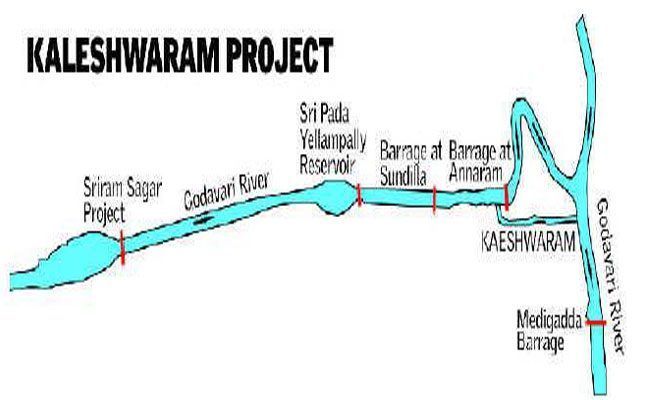Kaleshwaram Project
Jun 21, 2019 • 124 views
Water is the driving force of all nature
All this started with the motive of our honorable Telangana chief minister K Chandra Shekar Rao to visualize Telangana as "Golden Telangana''. It was his second biggest dream after the formation of Telangana.
The Rs. 80,000 crores Kaleshwaram irrigation project billed as the world's largest multi-stage multipurpose lift irrigation scheme was inaugurated today i.e. June 21st, 2019 by Mr. Rao. Andhra Pradesh Chief Minister Jagan Mohan Reddy and his Maharashtra counterpart Devendra Fadnavis were among the VIP guests at the grand event.

The reason behind inviting Maharashtra's CM Devendra Fadnavis
It was the water sharing agreement between Telangana and Maharashtra.
He has been invited because the Maharashtra government in March 2016 agreed to Telangana's proposal for the water-sharing agreement if a dam or barrage was constructed across the Godavari in Telangana which had been the cause for acrimony between united AP and Maharashtra for nearly four decades.
On March 8th, 2016, the Telangana government had agreed with the Maharashtra State government, putting an end to the decades-old differences and objections over the issue. This agreement has paved the way for the construction of the Kaleshwaram project at Medigadda in the Jayshankar Bhupalpalli district.
The total length of the Kaleshwaram project is approximately 1,832 km, of which 1,531 km is gravity canals and 203 km comprises water tunnels.
Why Kaleshwaram irrigation project is unique
This project is unique because Telangana will harness water at the confluence of two rivers with the Godavari by constructing a barrage at Medigadda in Jayshankar Bhoopalpally district and reverse pump the water into the main Godavari river and divert it through lifts and pumps into a huge and complex system of reservoirs, water tunnels, pipelines, and canals. The project has set many records with the world's longest water tunnels, aqua ducts, underground surge pools, and the biggest pumps.

Pros and Cons of this project
The project is going to irrigate 45 lakh acres and help in the production of two crops a year. It will also cater to the drinking water needs of 70 percent of the state. An approximate 16 thousand million cubic feet (TMC) will support industries.
The project will see at least 2 TMC of Godavari water lifted daily to the Medigadda Barrage and then transported via six more levels to Konda Pochamma Sagar Reservoir, which is located approximately 60 kilometers from Hyderabad.
Kaleshwaram irrigation project suffers the worst setback as Water Commission calls it a new project.
The Telangana government, which sees the reconstructed irrigation projects with huge amounts of escalations as prestigious, went on to step up pressure on various central agencies and government with repeated representations while accusing vested interests of attempting to stall its projects.
The Hot Question
Under this project, farmers are shown to get a benefit ofRs 1.56 lakh per acre of chili cultivation from the current level of Rs 12,000. This is an increase of 1,300 percent or 13 times.
Normally when the production of chilies increases by 20 percent more than the average of the previous year, the prices fall precipitously with no buyers in the market. This was the case last year when farmers in their frustration burnt the produce. What would be the market response if chilies are produced 20 times more than the current level?
The Way Forward
What would be the total cost of Part I of the Kaleshwaram project by the time it is completed?
When will Phase 1 be completed?
Once it is completed, what would be the annual maintenance cost?
What amount should the state government spend on each acre for providing water for irrigation?
What would farmers actually gain from growing crops with such expensive water?
How will the government recover the cost by selling water to industry and domestic users to the tune of Rs 6,000 crore annually?
Now that the project has started and a lot of money is being spent, what can be done?
This is typical of irrigation projects. It is a sunken cost fallacy. A lot more can still be done to avoid huge costs, by referring the designs to independent experts and incorporating changes. That will save money and avoid huge costs.
